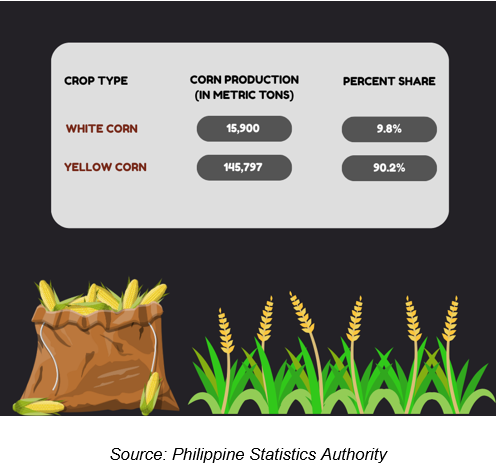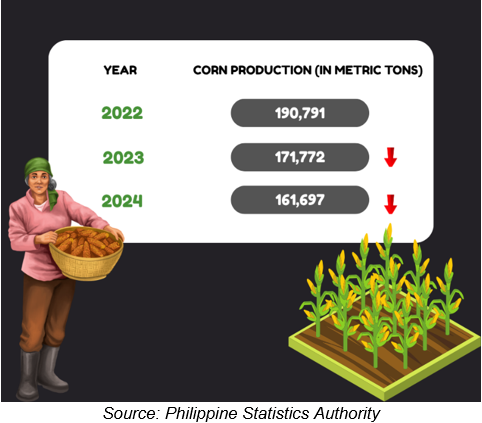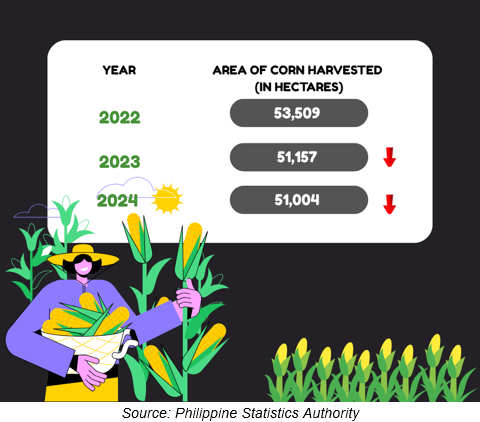This special release presents the Corn Production of Cordillera Administrative Region for 2024. The 2024 data include the estimates of corn production and area harvested for analysis which serve as a basis for policymaking and projects on corn. The data provided in this special release were taken from the latest available data of the Corn Production Survey (CPS) of the Crops Statistics Division, Economic Sector Statistics Service, Sectoral Statistics Office of the Philippine Statistics Authority (PSA). This information presented in this special release was taken from www.openstat.psa.gov.ph.
Corn production decreases in 2024
In 2024, agricultural farms in the Cordillera Administrative Region (CAR) collectively produced a total of 323,394 metric tons of corn. This output was drawn from two major corn crop types: white corn and yellow corn. Among these, yellow corn provided the largest contribution with a production of 145,797 metric tons while white corn contributed an estimated 15,900 metric tons to the region’s total corn production.
Compared to the previous year's performance, a decline in total production was observed. In 2023, CAR recorded a total corn production of 171,772 metric tons. The 2024 figure of 161,697 metric tons reflects a reduction of approximately 5.9%, signaling a slowdown in the region’s corn production sector.
A closer look at each corn type reveals varying trends. Yellow corn production experienced the most significant drop, decreasing from 145,797 metric tons to 156,463 metric tons - a reduction of 6.8%. In contrast, white corn production recorded a modest increase of 3.9%.
In terms of their proportionate shares of the region’s total corn production in 2024, yellow corn remained the dominant type, accounting for 90.2%, white corn followed with a contribution of 9.8%.
Figure 1. Corn Production and Percent Share by Crop Type, CAR: 2024

In 2024, the Philippines recorded a nationwide corn production volume of approximately 8.14 million metric tons, underscoring the crop's vital role in the country’s agricultural sector. Despite this substantial national output, CAR contributed only a small portion - accounting for just 2% of the total – positioning it among the least productive regions in terms of corn cultivation. This modest contribution may be attributed to several limiting factors, including mountainous terrain, limited arable land, and the region’s emphasis on other highland crops. Nevertheless, CAR holds untapped potential for expanding feed-grade corn production, particularly through integrated livestock development initiatives.
Figure 2. Corn Production by Year, CAR: 2022-2024

Figure 2 illustrates the overall trend of corn production in the Cordillera region from 2022 to 2024. The data show that production peaked in 2022 at 190,791 metric tons.
This high point was followed by a notable decline in 2023, with output dropping to 171,772 metric tons. The downward trend continued into 2024, as production further decreased to 161,697 metric tons. This consistent decline over the three-year span suggests a sustained contraction in corn production across the region.
2024 sees decrease in corn harvested area in the Cordillera region
In 2024, agricultural lands across the region harvested corn over an estimated area of 51,004 hectares for both yellow and white corn. Yellow corn accounted for the larger share at approximately 44,522 hectares, while white corn occupied about 6,482 hectares.
Compared to the 51,156 hectares harvested in 2023, the 2024 figure marks a slight decline of roughly 0.3%, signaling a modest yet consistent slowdown in the region’s corn production performance.
Figure 4. Area of Corn Harvested and Percent Share by Crop Type, CAR: 2024

Further analysis reveals that yellow corn was primarily responsible for the overall contraction, with its harvested area declining by approximately 0.5% - from 44,746 hectares in 2023 to 44,522 hectares in 2024. In contrast, white corn saw a slight increase of around 1.1% over the same period.
Despite the decline, yellow corn remained the dominant crop, accounting for approximately 87.3% of the total corn area harvested in the region in 2024, while white corn constituted the remaining 12.7%.
At the national scale, the Philippines harvested around 2,456,495 hectares of corn in 2024, underscoring the crop’s significance to the country’s agriculture sector. Within this context, the Cordillera Administrative Region contributed only 2.1% of the total, reflecting its relatively smaller role in national corn production.
Figure 4. Area of Corn Harvested by Year, CAR: 2022-2024

As illustrated in Figure 4, the area of corn harvested in the region has shown a declining trend over the past three years. The highest recorded figure was in 2022, at 53,509 hectares, followed by successive annual reductions—to 51,157 hectares in 2023 and further to 51,004 hectares in 2024.
(SGD)
VILLAFE P. ALIBUYOG
Regional Director
Designation Initials Date
CSS AFRB 30 June 2025
SA DBRGL 26 June 2025
Technical Notes
The data collection for Corn Production Survey is conducted during the first 10 days of April, July, October, and December.
Crop Production- refers to the quantity produced and harvested for a particular crop during the reference period. It includes those harvested but damaged, stolen, given away consumed, given as harvester’s and thresher’s shares, reserved, etc. It excludes those produced but not harvested due to low price, lack of demand, force majeure, or fortuitous events, etc.
Yellow corn - used generally as feed grains. It includes all types of corn other than white.
White corn - type of corn used primarily for human consumption.
Harvest Area - refers to the actual area from which harvests were realized. This excludes crop areas that were totally damaged. It may be smaller than the area planted.
Metric ton - refers to a unit that is being used which is equal to 1,000 kilograms.
Farmgate Price - refers to the price received by farmers for their crops at the location of farm. Thus, the marketing costs, such as the transport and other marketing cost (if any) incurred in selling the produce are not included in the farm prices.
Food and Agriculture Organization (FAO) definition: Prices received by farmers for their produce at the location of farm. Thus, the costs of transporting from the farm to the nearest market or first point of sale and market charges (if any) for selling the produce are, by definition, not included in the farm prices. (www.fao.org)

